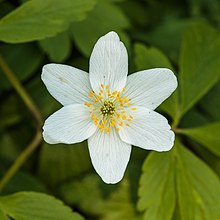Anemonoides nemorosa

Anemonoides nemorosa (syn. Anemone nemorosa), the wood anemone, is an early-spring flowering plant in the buttercup family Ranunculaceae, native to Europe.[1] Other common names include windflower, thimbleweed, and smell fox, an allusion to the musky smell of the leaves. It is a perennial herbaceous plant growing 5–15 cm (2–6 in) tall.
Anemonoides nemorosa is a rhizomatous herbaceous perennial plant less than 30 centimetres (12 in) in height. The compound basal leaves are palmate or ternate (divided into three lobes).[2]:106 They grow from underground root-like stems called rhizomes and die back down by mid summer (summer dormant).
The plants start blooming in spring, March to May in the British Isles[3]:28 soon after the foliage emerges from the ground. The flowers are solitary, held above the foliage on short stems, with a whorl of three palmate or palmately-lobed leaflike bracts beneath. The flowers are 2 centimetres (0.8 in) diameter, with six or seven (and on rare occasions eight to ten) tepals (petal-like segments) with many stamens. In the wild the flowers are usually white but may be pinkish, lilac or blue, and often have a darker tint on the backs of the tepals.
The yellow wood anemone (Anemonoides ranunculoides) is slightly smaller, with yellow flowers and usually without basal leaves.[2]
Wood sorrel Oxalis acetosella, which grows in similar shaded places, can be readily distinguished by its ternate and clover-like leaves and smaller flowers with 5 white petals and 5 sepals.[3][4]
